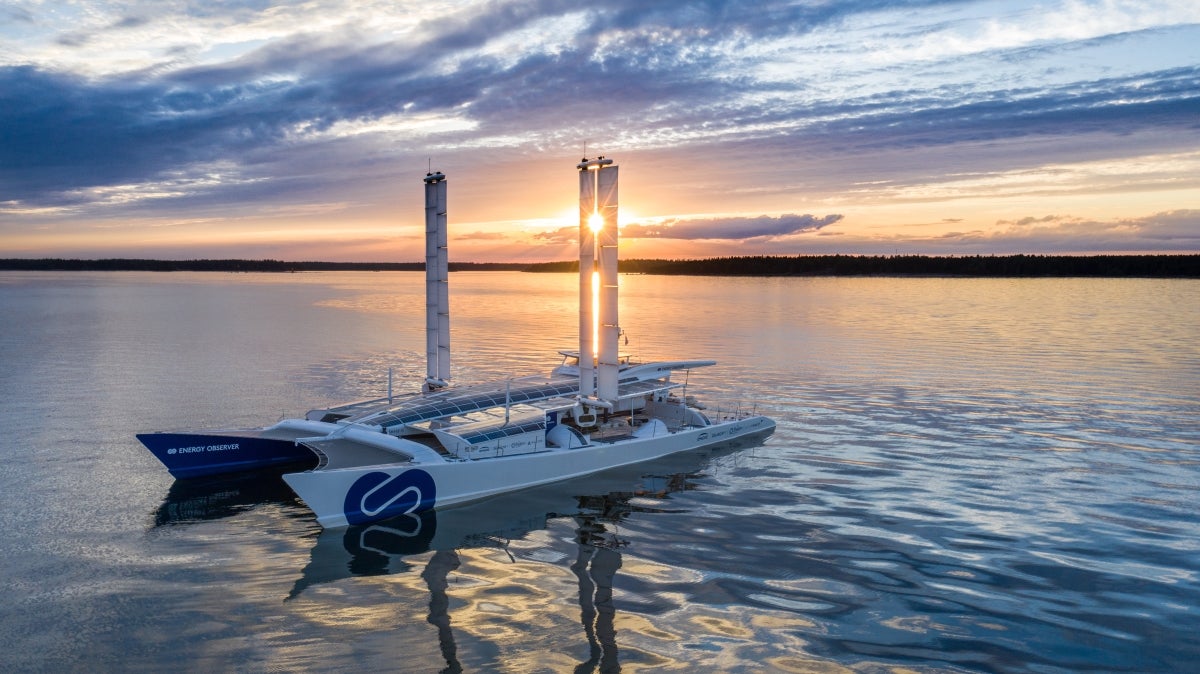
The world’s first energy self-sufficient seagoing vessel powered by hydrogen, Energy Observer, arrived in London, UK, marking its 47th stopover after travelling 17,815 nautical miles since leaving Saint-Malo, France in 2017.
During a European tour, the Energy Observer visited 25 countries in a bid to advocate the importance of achieving carbon neutrality by 2050.
The 30m-long ‘Floating Laboratory’ will remain stationed by Tower Bridge until 13 October after finishing the tour, which it completed without emitting carbon dioxide (CO2), fine particles or noise pollution.
Combining three renewable energy sources – including solar, wind and hydro-kinetic – the vessel is capable of producing hydrogen on-board using seawater via electrolysis, before storing it in tanks beneath the surface of the catamaran.
For collecting solar energy, the vessel features solar panels spanning an area of 141m2. The OceanWings, a rotating self-supporting and automated propulsion system, optimise the energy input of the wind and increase energy production during navigation through the production of hydroelectric power. This makes it possible for it to produce hydrogen while sailing without having to stopover.
Led by founder and captain Victorien Erussard, the ship has been named France’s chief ambassador for the UN’s 17 sustainable development goals.
On the completion of the voyage, Erussard said that projects such as this “remind us of the urgency to act in the face of climate change, which is particularly prominent in this polar zone”.
He added: “Energy Observer was able to discover the many initiatives deployed by the major capitals of Northern Europe in terms of energy and environmental transition. We also managed a navigation of 5,700km from Saint-Petersburg to Spitsbergen in the Arctic in total autonomy.”
He argued that the majority of ships today still rely on heavy and toxic bunker fuel, producing nearly one billion tons of CO2 emissions annually, and that the Energy Observer aims to raise awareness of climate change.
Director-General of the International Renewable Energy Agency Francesco La Camera said: “Energy Observer shows that with the innovations and technologies available today, it’s possible to accelerate low-carbon development to meet our climate and sustainable development goals.
“Hydrogen based on renewables holds significant promise in the context of decarbonising transport and other sectors that are difficult to electrify. This boat underscores the fact that energy transition brings new opportunities in all end-use sectors.”
The completion of this mission was aimed to show that the shipping industry must prioritise strategies towards sustainability to achieve the regulations imposed by the International Maritime Organization (IMO). In April 2018, the IMO put in place a target to reduce greenhouse gas emissions from shipping by 50% by 2050.
Secretary General of the IMO Kitack Lim said that to achieve the goal, it’s important to “promote the uptake new technologies and technology transfer”.
“The IMO strategy is expected to drive a new propulsion revolution for ships. IMO GHG strategy on the reduction of greenhouse gas emissions from ships has sent a clear signal to innovators that this is the way forward. However, action needs to be accelerated if its goals are to be achieved,” Lim added.
The ambassador of France to the IMO HE Geneviève Van Rossum said that the Energy Observer project “confirms the feasibility of zero-emission maritime transport”.
“This vessel is also a testimony of France’s political commitment to the issue of reducing carbon emissions in the maritime sector,” Rossum added. “Energy Observer is a technological showcase of French industrial know-how, and of the dynamics of all French companies and institutions which engage in the energy transition. In order to achieve the objectives of the IMO strategy, new ships will have to use these technologies tomorrow.”
During the Northern European leg, the ship visited Antwerp, Amsterdam, Hamburg, Copenhagen, Stockholm, Helsinki, Tallinn, Saint Petersburg, Spitsbergen, Tromsø, Bogø and Alesund along the coast of Norway, finishing off with a stop in Aberdeen before London.
Next year, the yacht is set to visit North Asia and intends to be in Tokyo to coincide with the Olympic Games. It will then relocate to the Pacific and the USA’s West Coast in 2021, finishing with Central America and the East Coast in 2022.



